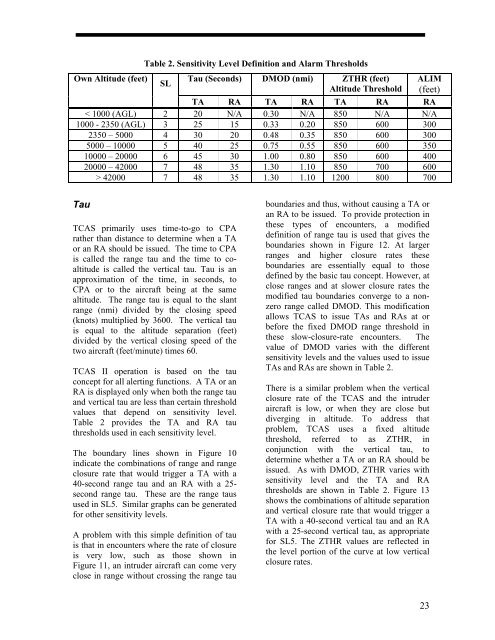You also want an ePaper? Increase the reach of your titles
YUMPU automatically turns print PDFs into web optimized ePapers that Google loves.
Table 2. Sensitivity Level Definition and Alarm Thresholds<br />
Own Altitude (feet) Tau (Seconds) DMOD (nmi) ZTHR (feet) ALIM<br />
SL<br />
Altitude Threshold (feet)<br />
TA RA TA RA TA RA RA<br />
< 1000 (AGL) 2 20 N/A 0.30 N/A 850 N/A N/A<br />
1000 - 2350 (AGL) 3 25 15 0.33 0.20 850 600 300<br />
2350 – 5000 4 30 20 0.48 0.35 850 600 300<br />
5000 – 10000 5 40 25 0.75 0.55 850 600 350<br />
10000 – 20000 6 45 30 1.00 0.80 850 600 400<br />
20000 – 42000 7 48 35 1.30 1.10 850 700 600<br />
> 42000 7 48 35 1.30 1.10 1200 800 700<br />
Tau<br />
<strong>TCAS</strong> primarily uses time-to-go to CPA<br />
rather than distance to determine when a TA<br />
or an RA should be issued. The time to CPA<br />
is called the range tau and the time to coaltitude<br />
is called the vertical tau. Tau is an<br />
approximation of the time, in seconds, to<br />
CPA or to the aircraft being at the same<br />
altitude. The range tau is equal to the slant<br />
range (nmi) divided by the closing speed<br />
(knots) multiplied by 3600. The vertical tau<br />
is equal to the altitude separation (feet)<br />
divided by the vertical closing speed of the<br />
two aircraft (feet/minute) times 60.<br />
<strong>TCAS</strong> <strong>II</strong> operation is based on the tau<br />
concept for all alerting functions. A TA or an<br />
RA is displayed only when both the range tau<br />
and vertical tau are less than certain threshold<br />
values that depend on sensitivity level.<br />
Table 2 provides the TA and RA tau<br />
thresholds used in each sensitivity level.<br />
The boundary lines shown in Figure 10<br />
indicate the combinations of range and range<br />
closure rate that would trigger a TA with a<br />
40-second range tau and an RA with a 25-<br />
second range tau. These are the range taus<br />
used in SL5. Similar graphs can be generated<br />
for other sensitivity levels.<br />
A problem with this simple definition of tau<br />
is that in encounters where the rate of closure<br />
is very low, such as those shown in<br />
Figure 11, an intruder aircraft can come very<br />
close in range without crossing the range tau<br />
boundaries and thus, without causing a TA or<br />
an RA to be issued. To provide protection in<br />
these types of encounters, a modified<br />
definition of range tau is used that gives the<br />
boundaries shown in Figure 12. At larger<br />
ranges and higher closure rates these<br />
boundaries are essentially equal to those<br />
defined by the basic tau concept. However, at<br />
close ranges and at slower closure rates the<br />
modified tau boundaries converge to a nonzero<br />
range called DMOD. This modification<br />
allows <strong>TCAS</strong> to issue TAs and RAs at or<br />
before the fixed DMOD range threshold in<br />
these slow-closure-rate encounters. The<br />
value of DMOD varies with the different<br />
sensitivity levels and the values used to issue<br />
TAs and RAs are shown in Table 2.<br />
There is a similar problem when the vertical<br />
closure rate of the <strong>TCAS</strong> and the intruder<br />
aircraft is low, or when they are close but<br />
diverging in altitude. To address that<br />
problem, <strong>TCAS</strong> uses a fixed altitude<br />
threshold, referred to as ZTHR, in<br />
conjunction with the vertical tau, to<br />
determine whether a TA or an RA should be<br />
issued. As with DMOD, ZTHR varies with<br />
sensitivity level and the TA and RA<br />
thresholds are shown in Table 2. Figure 13<br />
shows the combinations of altitude separation<br />
and vertical closure rate that would trigger a<br />
TA with a 40-second vertical tau and an RA<br />
with a 25-second vertical tau, as appropriate<br />
for SL5. The ZTHR values are reflected in<br />
the level portion of the curve at low vertical<br />
closure rates.<br />
23



